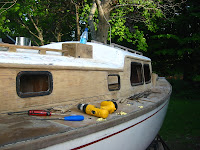.



Once these were off, and the glass/hardware was out, I got a better look at how they put the cabin house walls together.

Now, I just have to figure out the best way to address the gaps. So far the favored plan of attack is to run a router along the gap, using straight strip of wood as a guide. Make the gap an even width/depth and fill it with a new piece of teak. It should be able to then swell and contract as designed and look as new.

Nice knees.

No comments:
Post a Comment